| May 1, 2006
More Uses for SACD and DVD-Audio
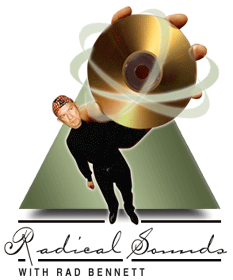 In the March "Radical Sounds," I wrote about
BIS’s SACD set of the complete organ music of J.S. Bach: five discs with a playing
time of more than 20 hours, achieved by eschewing the available multichannel and CD
options and using only the high-resolution two-channel tracks. This month, some more
unique uses of high-resolution formats have come to my attention. In the March "Radical Sounds," I wrote about
BIS’s SACD set of the complete organ music of J.S. Bach: five discs with a playing
time of more than 20 hours, achieved by eschewing the available multichannel and CD
options and using only the high-resolution two-channel tracks. This month, some more
unique uses of high-resolution formats have come to my attention.
First is a sampler disc from M•A Recordings, produced
in conjunction with Crystal Cable and titled M•A on SA. By eliminating the
multichannel option, it offers 108+ minutes of SACD and 73+ minutes of PCM CD two-channel
music. Note the different timings -- rather than one program duplicated on the CD and SACD
tracks, the two formats contain totally different programs.
The two excellent programs -- selected by Todd Garfinkle,
M•A’s producer and chief engineer -- display his label’s considerable
strengths and range from classical to world music. I remarked, in reviewing a guitar
recital by young Grzegorz Krawiec, that M•A’s CD recordings are incredibly close
to the quality achieved on most SACD releases. To hear selections from them in SACD format
on this sampler is a wonderful revelation. This disc, available only from the
company’s website, will have you coming back for more. But my hat is off to M•A
mainly for using the SACD format in an imaginative way, as BIS did with its Bach release.
New releases of DVD-Audio discs are getting harder to find,
and one innovative one has been virtually hidden from the public. That is a set, The
Lord of the Rings: The Fellowship of the Ring -- The Complete Recordings [Reprise
49454-2]. The deluxe set contains all of the music Howard Shore wrote and recorded
for The Fellowship of the Ring on three CDs, in a handsome hardcover
"book" box plus a high-quality booklet on the themes and the music. If certain
things are subtracted from the mix, a DVD can hold a longer playing time. One way is to
reduce the bit rate for the rear channels. I suspect that was done here, though I
couldn’t tell in the overall listening because the contents of all three CDs are also
provided on a single DVD-A disc in splendid multichannel sound! This disc seems carelessly
thrown in at the last minute on the inside front cover of the outer box, pinned on an
inadequate hub from which it can easily escape. When you close the cover, you have to do
it carefully lest the disc hang up and be severely damaged. To add insult to injury, on
the label side of the DVD-A appears the inscription: "Entire Score in Superior
Sound." If it’s so superior (and it really is), then why treat this disc in such
a philistine manner? It doesn’t even include a list of chapter stops. So much for
Time Warner’s commitment to DVD-A. No wonder this DVD-A has been kept a veritable
secret. But I highly recommend it. Few discs have taken advantage of the potentially
longer playing time of DVD-A; it’s good to have one more.
There you have several innovative uses of the both
advanced-resolution formats from producers with some degree of imagination. I hope there
are more to come. Now here are six releases that kick off the summer with great sound:
Eybler: Symphonies 1 & 2; Overture
L’Orchestre de Chambre de Genčve; Michael Hofstetter, conductor.
CPO 777 104, Hybrid Multichannel SACD.
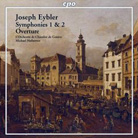 Joseph Eybler (1765-1846), all but
forgotten today, was highly regarded in Vienna during his lifetime. Both Haydn and Mozart
endorsed him, and Empress Maria Theresa supported him financially. He was asked to
complete Mozart’s Requiem after that composer’s death, but declined.
(Oddly, he suffered a debilitating, career-ending stroke in 1833 while conducting that
very work.) The two symphonies on this welcome disc are models of classical clarity imbued
with a Haydn-esque zest for living. The Menuet movements reveal peasant roots, while the
polished variations and fugal passages are masterfully handled, and Eybler’s
first-rate writing for winds shines in many passages. Hearing the Chamber Orchestra of
Geneva was as much a revelation as discovering the music. This ensemble must be counted
one of the greatest small orchestras in the world. Every section is solid, and the players
perform with virtuoso style and an enthusiasm seldom encountered in more famous and more
august ensembles. The spirit must start with conductor Michael Hofstetter, who imparts a
zingy brio to every passage while not overlooking the music’s lyrical qualities. His
is a name to watch. The sound has attention-grabbing presence and is a model of clarity.
The program notes tout the orchestra’s 1200-seat hall as having "extraordinary
acoustics," a statement borne out by this recording. Joseph Eybler (1765-1846), all but
forgotten today, was highly regarded in Vienna during his lifetime. Both Haydn and Mozart
endorsed him, and Empress Maria Theresa supported him financially. He was asked to
complete Mozart’s Requiem after that composer’s death, but declined.
(Oddly, he suffered a debilitating, career-ending stroke in 1833 while conducting that
very work.) The two symphonies on this welcome disc are models of classical clarity imbued
with a Haydn-esque zest for living. The Menuet movements reveal peasant roots, while the
polished variations and fugal passages are masterfully handled, and Eybler’s
first-rate writing for winds shines in many passages. Hearing the Chamber Orchestra of
Geneva was as much a revelation as discovering the music. This ensemble must be counted
one of the greatest small orchestras in the world. Every section is solid, and the players
perform with virtuoso style and an enthusiasm seldom encountered in more famous and more
august ensembles. The spirit must start with conductor Michael Hofstetter, who imparts a
zingy brio to every passage while not overlooking the music’s lyrical qualities. His
is a name to watch. The sound has attention-grabbing presence and is a model of clarity.
The program notes tout the orchestra’s 1200-seat hall as having "extraordinary
acoustics," a statement borne out by this recording.
Georg Muffat: Apparatus musico-organisticus
Joseph Kelemen, organ.
Oehms OC 604, Hybrid Multichannel SACD.
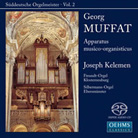 Georg Muffat (1653-1704) is scarcely a
household name now, but was well known in his day. He got around, too, meeting Lully in
France and Corelli in Italy. That and his French-Scottish ancestry perhaps explain the
eclectic nature of his music, which sounds neither French nor German but like something in
between. The works recorded on these two SACDs comprise 12 toccatas, a chaconne, a
passacaglia, and a set of variations. Most of it strikes me as quasi-majestic, with heavy
blocked chords, and the occasional spirited passage in dotted rhythm or a well-crafted
fugue. Organist Joseph Kelemen plays it all with precision and as much poetry as the music
allows. Two organs were used for the set (the reason is explained in the informative
notes), one a Silbermann instrument in Ebersmünster, the other a Freundt organ at
Kosterneuberg, both visually beautiful and pictured in full color on the booklet’s
covers. The sound is exceptionally realistic, and the multichannel tracks define a
recognizably different space for each instrument. That’s an impressive feat and a
positive vote for multichannel sound, but a mite irritating -- the tracks alternate the
instruments and their venues, rather approximating what could have been a continuous
recital for each. Georg Muffat (1653-1704) is scarcely a
household name now, but was well known in his day. He got around, too, meeting Lully in
France and Corelli in Italy. That and his French-Scottish ancestry perhaps explain the
eclectic nature of his music, which sounds neither French nor German but like something in
between. The works recorded on these two SACDs comprise 12 toccatas, a chaconne, a
passacaglia, and a set of variations. Most of it strikes me as quasi-majestic, with heavy
blocked chords, and the occasional spirited passage in dotted rhythm or a well-crafted
fugue. Organist Joseph Kelemen plays it all with precision and as much poetry as the music
allows. Two organs were used for the set (the reason is explained in the informative
notes), one a Silbermann instrument in Ebersmünster, the other a Freundt organ at
Kosterneuberg, both visually beautiful and pictured in full color on the booklet’s
covers. The sound is exceptionally realistic, and the multichannel tracks define a
recognizably different space for each instrument. That’s an impressive feat and a
positive vote for multichannel sound, but a mite irritating -- the tracks alternate the
instruments and their venues, rather approximating what could have been a continuous
recital for each.
Handel: Saul
Rosemary Joshua, Emma Bell, Lawrence Zazzo, Jeremy Ovenden, Michael Slattery, Finnur
Bjranason, Henry Waddington, Gidon Saks; RIAS-Kammerchor, Concerto Köln; René Jacobs,
conductor.
Harmonia Mundi 801877.78, Hybrid Multichannel SACD.
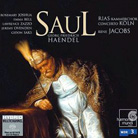 Handel wrote the oratorio Saul in
1738, during a particularly productive time of his life: It was followed by Israel in
Egypt (1739) and Messiah (1740). In fact, the librettist for both Messiah
and Saul was Charles Jennens. It is interesting that the two works on which Jennens
collaborated were among the most performed not only in Handel’s lifetime, but during
the centuries since. It’s little wonder that Saul is so popular -- it bursts
with grand melodies and inventive orchestration. This performance goes to the top of the
class as the best ever recorded. Jacobs goes straight to the work’s heart, capturing
every bit of its poetry and drama. The young soloists are superb, and the chorus
enunciates with clarity and sings with flawless pitch, while at every turn, the orchestral
players astound with their virtuosity and glowing tone. The continuo is exceptionally well
handled, and varied by alternating, harp, lute, two harpsichords, and organ. The recording
is also perfect, with ideal balances. The high-resolution sound allows every shading to be
heard, and the rear channels give the impression of a medium-size hall -- a remarkable
feat, since the notes disclose that this is a studio recording. This two-SACD set should
be on everyone’s Best of 2006 list. Handel wrote the oratorio Saul in
1738, during a particularly productive time of his life: It was followed by Israel in
Egypt (1739) and Messiah (1740). In fact, the librettist for both Messiah
and Saul was Charles Jennens. It is interesting that the two works on which Jennens
collaborated were among the most performed not only in Handel’s lifetime, but during
the centuries since. It’s little wonder that Saul is so popular -- it bursts
with grand melodies and inventive orchestration. This performance goes to the top of the
class as the best ever recorded. Jacobs goes straight to the work’s heart, capturing
every bit of its poetry and drama. The young soloists are superb, and the chorus
enunciates with clarity and sings with flawless pitch, while at every turn, the orchestral
players astound with their virtuosity and glowing tone. The continuo is exceptionally well
handled, and varied by alternating, harp, lute, two harpsichords, and organ. The recording
is also perfect, with ideal balances. The high-resolution sound allows every shading to be
heard, and the rear channels give the impression of a medium-size hall -- a remarkable
feat, since the notes disclose that this is a studio recording. This two-SACD set should
be on everyone’s Best of 2006 list.
James Horner: The Legend of Zorro
Sony Classical 82876-76226-2, Hybrid Multichannel SACD.
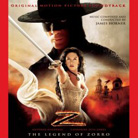 I am no fan of James Horner’s often
derivative film scores. I play the "I wonder what classic he’s lifted this
time?" game -- Schumann’s Symphony No.3 for Willow, etc. In this score he
borrows from Alfred Newman, flamenco in general, and his own score for the first Antonio
Banderas Zorro film. There’s lots of guitar, pompous brass fanfares, and
pulsing rhythms. But this recording sounds so wonderful that I didn’t mind all
that, and just let myself be swept away. I had expected, because it’s a soundtrack
recording, that there’d be way too much primary information in the surrounds, but
that’s not the case. The music is up front in the left, right, and center channels,
the surrounds providing a warm, glowing reverb. And those front channels are clean as a
whistle. The flamenco dancing and deep-bass thuds will grab the attention, but more
important is the sweet, airy sound of upper strings -- better than on most any classical
SACD I have heard. The deep soundstage, too, is impressive. The brass -- the horns in
particular -- sound behind the strings, but are absolutely clear and forceful when needed.
Percussion instruments such as cymbals have undeniable presence, yet sound at the back of
the orchestra rather than in your face. The high resolution of the SACD format allows for
much more subtlety than is heard in the average soundtrack recording. Simon Rhodes is the
one to thank for this sterling engineering job. I am no fan of James Horner’s often
derivative film scores. I play the "I wonder what classic he’s lifted this
time?" game -- Schumann’s Symphony No.3 for Willow, etc. In this score he
borrows from Alfred Newman, flamenco in general, and his own score for the first Antonio
Banderas Zorro film. There’s lots of guitar, pompous brass fanfares, and
pulsing rhythms. But this recording sounds so wonderful that I didn’t mind all
that, and just let myself be swept away. I had expected, because it’s a soundtrack
recording, that there’d be way too much primary information in the surrounds, but
that’s not the case. The music is up front in the left, right, and center channels,
the surrounds providing a warm, glowing reverb. And those front channels are clean as a
whistle. The flamenco dancing and deep-bass thuds will grab the attention, but more
important is the sweet, airy sound of upper strings -- better than on most any classical
SACD I have heard. The deep soundstage, too, is impressive. The brass -- the horns in
particular -- sound behind the strings, but are absolutely clear and forceful when needed.
Percussion instruments such as cymbals have undeniable presence, yet sound at the back of
the orchestra rather than in your face. The high resolution of the SACD format allows for
much more subtlety than is heard in the average soundtrack recording. Simon Rhodes is the
one to thank for this sterling engineering job.
Sir Edward Meets Father Willis
Elgar: Polonia; Chanson de Matin; Prelude and Angel’s
Farewell from The Dream of Gerontius; Contrasts: The Gavotte -- AD 1700 and
1900; Enigma Variations
Simon Nieminnski, organ, Saint Mary’s Episcopal Cathedral, Edinburgh, Scotland.
Pro Organo SACD-7199, Hybrid Multichannel SACD.
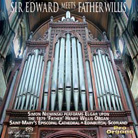 Pro Organo is a recording company
founded by Frederick Hohman. An accomplished organist, Hohman scours the countryside to
find the most worthy instruments to record, then secures the best of today’s virtuoso
organists to play them. He has now branched out to make distinguished choral recordings as
well, always with a surprise card up his sleeve, such as band or brass and organ. What
makes Pro Organo so singular is that Hohman is also a superb recording engineer who knows
the technical side of recording as well as the artistic, and has been able to record the
"King of Instruments" like no other producer. So it’s no surprise to find
him embarking on a series of multichannel SACDs. This one is the first, recorded in DSD
and offered in 5.1 channels. The organ was built by Willis in 1879 and has a warm,
romantic sound just right for Elgar’s music. Simon Nieminski seems the ideal soloist,
too, bringing flair, bravura, and color to every passage. The recording captures the sound
of the instrument, from the lowest rumble to the brightest pipe, with pinpoint accuracy,
using the surrounds to convey a wonderful feeling of space. In his notes, Hohman notes the
hiss-like sound of the winding system, but that needs explaining only for those listening
to this marvelous disc’s CD layer. Anyone listening to either of its SACD layers,
stereo or multichannel, will be easily able to tell, thanks to the high resolution, that
the hiss is air, not electronic noise. That’s how accurate this recording is. This
first SACD for Pro Organo is a significant debut, and I can’t wait for the encore.
(If you can’t find Pro Organo where you usually buy recordings, go to www.zarex.com, where you can shop the
entire catalog.) Pro Organo is a recording company
founded by Frederick Hohman. An accomplished organist, Hohman scours the countryside to
find the most worthy instruments to record, then secures the best of today’s virtuoso
organists to play them. He has now branched out to make distinguished choral recordings as
well, always with a surprise card up his sleeve, such as band or brass and organ. What
makes Pro Organo so singular is that Hohman is also a superb recording engineer who knows
the technical side of recording as well as the artistic, and has been able to record the
"King of Instruments" like no other producer. So it’s no surprise to find
him embarking on a series of multichannel SACDs. This one is the first, recorded in DSD
and offered in 5.1 channels. The organ was built by Willis in 1879 and has a warm,
romantic sound just right for Elgar’s music. Simon Nieminski seems the ideal soloist,
too, bringing flair, bravura, and color to every passage. The recording captures the sound
of the instrument, from the lowest rumble to the brightest pipe, with pinpoint accuracy,
using the surrounds to convey a wonderful feeling of space. In his notes, Hohman notes the
hiss-like sound of the winding system, but that needs explaining only for those listening
to this marvelous disc’s CD layer. Anyone listening to either of its SACD layers,
stereo or multichannel, will be easily able to tell, thanks to the high resolution, that
the hiss is air, not electronic noise. That’s how accurate this recording is. This
first SACD for Pro Organo is a significant debut, and I can’t wait for the encore.
(If you can’t find Pro Organo where you usually buy recordings, go to www.zarex.com, where you can shop the
entire catalog.)
Sibelius: Kullervo
Peter Mattei, baritone; Monica Groop, mezzo-soprano; London Symphony Chorus and Orchestra;
Sir Colin Davis, conductor.
LSO Live 0574, Hybrid Multichannel SACD.
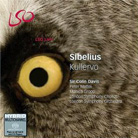 The sprawling epic Kullervo --
part symphony, part oratorio, part tone poem -- was seldom heard in the US until 30 or so
years ago, nor was it often recorded. There are now several good versions on CD, but none
as good as this dynamic reading. Sir Colin Davis has always been considered a great
interpreter of Sibelius’s works, and his Philips set of the symphonies is highly
regarded, but this recording goes beyond that. Davis searches every nook and cranny of
this craggy work and inspires the players of the London Symphony to do themselves proud.
The LSO strings sound more voluptuous than I have ever heard them, the woodwind solos are
always on the mark, and the brass speak with golden authority. The work is scored for male
voices only; the tenors and basses of the LSO Chorus are sonorous and enunciate clearly.
The recording is big and bold, with thundering bass and heart-pounding drums. (The
applause, which itself must have been thunderous, has been edited out.) These days, LSO
Live is making the best live-performance recordings of any label. The sprawling epic Kullervo --
part symphony, part oratorio, part tone poem -- was seldom heard in the US until 30 or so
years ago, nor was it often recorded. There are now several good versions on CD, but none
as good as this dynamic reading. Sir Colin Davis has always been considered a great
interpreter of Sibelius’s works, and his Philips set of the symphonies is highly
regarded, but this recording goes beyond that. Davis searches every nook and cranny of
this craggy work and inspires the players of the London Symphony to do themselves proud.
The LSO strings sound more voluptuous than I have ever heard them, the woodwind solos are
always on the mark, and the brass speak with golden authority. The work is scored for male
voices only; the tenors and basses of the LSO Chorus are sonorous and enunciate clearly.
The recording is big and bold, with thundering bass and heart-pounding drums. (The
applause, which itself must have been thunderous, has been edited out.) These days, LSO
Live is making the best live-performance recordings of any label.
...Rad Bennett
radb@ultraaudio.com

All contents copyright Schneider Publishing Inc., all rights
reserved.
Any reproduction, without permission, is prohibited.
Ultra Audio is part of the SoundStage! Network.
A world of websites and publications for audio, video, music, and movie enthusiasts. |

 In the March
In the March  Joseph Eybler (1765-1846), all but
forgotten today, was highly regarded in Vienna during his lifetime. Both Haydn and Mozart
endorsed him, and Empress Maria Theresa supported him financially. He was asked to
complete Mozart’s Requiem after that composer’s death, but declined.
(Oddly, he suffered a debilitating, career-ending stroke in 1833 while conducting that
very work.) The two symphonies on this welcome disc are models of classical clarity imbued
with a Haydn-esque zest for living. The Menuet movements reveal peasant roots, while the
polished variations and fugal passages are masterfully handled, and Eybler’s
first-rate writing for winds shines in many passages. Hearing the Chamber Orchestra of
Geneva was as much a revelation as discovering the music. This ensemble must be counted
one of the greatest small orchestras in the world. Every section is solid, and the players
perform with virtuoso style and an enthusiasm seldom encountered in more famous and more
august ensembles. The spirit must start with conductor Michael Hofstetter, who imparts a
zingy brio to every passage while not overlooking the music’s lyrical qualities. His
is a name to watch. The sound has attention-grabbing presence and is a model of clarity.
The program notes tout the orchestra’s 1200-seat hall as having "extraordinary
acoustics," a statement borne out by this recording.
Joseph Eybler (1765-1846), all but
forgotten today, was highly regarded in Vienna during his lifetime. Both Haydn and Mozart
endorsed him, and Empress Maria Theresa supported him financially. He was asked to
complete Mozart’s Requiem after that composer’s death, but declined.
(Oddly, he suffered a debilitating, career-ending stroke in 1833 while conducting that
very work.) The two symphonies on this welcome disc are models of classical clarity imbued
with a Haydn-esque zest for living. The Menuet movements reveal peasant roots, while the
polished variations and fugal passages are masterfully handled, and Eybler’s
first-rate writing for winds shines in many passages. Hearing the Chamber Orchestra of
Geneva was as much a revelation as discovering the music. This ensemble must be counted
one of the greatest small orchestras in the world. Every section is solid, and the players
perform with virtuoso style and an enthusiasm seldom encountered in more famous and more
august ensembles. The spirit must start with conductor Michael Hofstetter, who imparts a
zingy brio to every passage while not overlooking the music’s lyrical qualities. His
is a name to watch. The sound has attention-grabbing presence and is a model of clarity.
The program notes tout the orchestra’s 1200-seat hall as having "extraordinary
acoustics," a statement borne out by this recording. Georg Muffat (1653-1704) is scarcely a
household name now, but was well known in his day. He got around, too, meeting Lully in
France and Corelli in Italy. That and his French-Scottish ancestry perhaps explain the
eclectic nature of his music, which sounds neither French nor German but like something in
between. The works recorded on these two SACDs comprise 12 toccatas, a chaconne, a
passacaglia, and a set of variations. Most of it strikes me as quasi-majestic, with heavy
blocked chords, and the occasional spirited passage in dotted rhythm or a well-crafted
fugue. Organist Joseph Kelemen plays it all with precision and as much poetry as the music
allows. Two organs were used for the set (the reason is explained in the informative
notes), one a Silbermann instrument in Ebersmünster, the other a Freundt organ at
Kosterneuberg, both visually beautiful and pictured in full color on the booklet’s
covers. The sound is exceptionally realistic, and the multichannel tracks define a
recognizably different space for each instrument. That’s an impressive feat and a
positive vote for multichannel sound, but a mite irritating -- the tracks alternate the
instruments and their venues, rather approximating what could have been a continuous
recital for each.
Georg Muffat (1653-1704) is scarcely a
household name now, but was well known in his day. He got around, too, meeting Lully in
France and Corelli in Italy. That and his French-Scottish ancestry perhaps explain the
eclectic nature of his music, which sounds neither French nor German but like something in
between. The works recorded on these two SACDs comprise 12 toccatas, a chaconne, a
passacaglia, and a set of variations. Most of it strikes me as quasi-majestic, with heavy
blocked chords, and the occasional spirited passage in dotted rhythm or a well-crafted
fugue. Organist Joseph Kelemen plays it all with precision and as much poetry as the music
allows. Two organs were used for the set (the reason is explained in the informative
notes), one a Silbermann instrument in Ebersmünster, the other a Freundt organ at
Kosterneuberg, both visually beautiful and pictured in full color on the booklet’s
covers. The sound is exceptionally realistic, and the multichannel tracks define a
recognizably different space for each instrument. That’s an impressive feat and a
positive vote for multichannel sound, but a mite irritating -- the tracks alternate the
instruments and their venues, rather approximating what could have been a continuous
recital for each. Handel wrote the oratorio Saul in
1738, during a particularly productive time of his life: It was followed by Israel in
Egypt (1739) and Messiah (1740). In fact, the librettist for both Messiah
and Saul was Charles Jennens. It is interesting that the two works on which Jennens
collaborated were among the most performed not only in Handel’s lifetime, but during
the centuries since. It’s little wonder that Saul is so popular -- it bursts
with grand melodies and inventive orchestration. This performance goes to the top of the
class as the best ever recorded. Jacobs goes straight to the work’s heart, capturing
every bit of its poetry and drama. The young soloists are superb, and the chorus
enunciates with clarity and sings with flawless pitch, while at every turn, the orchestral
players astound with their virtuosity and glowing tone. The continuo is exceptionally well
handled, and varied by alternating, harp, lute, two harpsichords, and organ. The recording
is also perfect, with ideal balances. The high-resolution sound allows every shading to be
heard, and the rear channels give the impression of a medium-size hall -- a remarkable
feat, since the notes disclose that this is a studio recording. This two-SACD set should
be on everyone’s Best of 2006 list.
Handel wrote the oratorio Saul in
1738, during a particularly productive time of his life: It was followed by Israel in
Egypt (1739) and Messiah (1740). In fact, the librettist for both Messiah
and Saul was Charles Jennens. It is interesting that the two works on which Jennens
collaborated were among the most performed not only in Handel’s lifetime, but during
the centuries since. It’s little wonder that Saul is so popular -- it bursts
with grand melodies and inventive orchestration. This performance goes to the top of the
class as the best ever recorded. Jacobs goes straight to the work’s heart, capturing
every bit of its poetry and drama. The young soloists are superb, and the chorus
enunciates with clarity and sings with flawless pitch, while at every turn, the orchestral
players astound with their virtuosity and glowing tone. The continuo is exceptionally well
handled, and varied by alternating, harp, lute, two harpsichords, and organ. The recording
is also perfect, with ideal balances. The high-resolution sound allows every shading to be
heard, and the rear channels give the impression of a medium-size hall -- a remarkable
feat, since the notes disclose that this is a studio recording. This two-SACD set should
be on everyone’s Best of 2006 list. I am no fan of James Horner’s often
derivative film scores. I play the "I wonder what classic he’s lifted this
time?" game -- Schumann’s Symphony No.3 for Willow, etc. In this score he
borrows from Alfred Newman, flamenco in general, and his own score for the first Antonio
Banderas Zorro film. There’s lots of guitar, pompous brass fanfares, and
pulsing rhythms. But this recording sounds so wonderful that I didn’t mind all
that, and just let myself be swept away. I had expected, because it’s a soundtrack
recording, that there’d be way too much primary information in the surrounds, but
that’s not the case. The music is up front in the left, right, and center channels,
the surrounds providing a warm, glowing reverb. And those front channels are clean as a
whistle. The flamenco dancing and deep-bass thuds will grab the attention, but more
important is the sweet, airy sound of upper strings -- better than on most any classical
SACD I have heard. The deep soundstage, too, is impressive. The brass -- the horns in
particular -- sound behind the strings, but are absolutely clear and forceful when needed.
Percussion instruments such as cymbals have undeniable presence, yet sound at the back of
the orchestra rather than in your face. The high resolution of the SACD format allows for
much more subtlety than is heard in the average soundtrack recording. Simon Rhodes is the
one to thank for this sterling engineering job.
I am no fan of James Horner’s often
derivative film scores. I play the "I wonder what classic he’s lifted this
time?" game -- Schumann’s Symphony No.3 for Willow, etc. In this score he
borrows from Alfred Newman, flamenco in general, and his own score for the first Antonio
Banderas Zorro film. There’s lots of guitar, pompous brass fanfares, and
pulsing rhythms. But this recording sounds so wonderful that I didn’t mind all
that, and just let myself be swept away. I had expected, because it’s a soundtrack
recording, that there’d be way too much primary information in the surrounds, but
that’s not the case. The music is up front in the left, right, and center channels,
the surrounds providing a warm, glowing reverb. And those front channels are clean as a
whistle. The flamenco dancing and deep-bass thuds will grab the attention, but more
important is the sweet, airy sound of upper strings -- better than on most any classical
SACD I have heard. The deep soundstage, too, is impressive. The brass -- the horns in
particular -- sound behind the strings, but are absolutely clear and forceful when needed.
Percussion instruments such as cymbals have undeniable presence, yet sound at the back of
the orchestra rather than in your face. The high resolution of the SACD format allows for
much more subtlety than is heard in the average soundtrack recording. Simon Rhodes is the
one to thank for this sterling engineering job. Pro Organo is a recording company
founded by Frederick Hohman. An accomplished organist, Hohman scours the countryside to
find the most worthy instruments to record, then secures the best of today’s virtuoso
organists to play them. He has now branched out to make distinguished choral recordings as
well, always with a surprise card up his sleeve, such as band or brass and organ. What
makes Pro Organo so singular is that Hohman is also a superb recording engineer who knows
the technical side of recording as well as the artistic, and has been able to record the
"King of Instruments" like no other producer. So it’s no surprise to find
him embarking on a series of multichannel SACDs. This one is the first, recorded in DSD
and offered in 5.1 channels. The organ was built by Willis in 1879 and has a warm,
romantic sound just right for Elgar’s music. Simon Nieminski seems the ideal soloist,
too, bringing flair, bravura, and color to every passage. The recording captures the sound
of the instrument, from the lowest rumble to the brightest pipe, with pinpoint accuracy,
using the surrounds to convey a wonderful feeling of space. In his notes, Hohman notes the
hiss-like sound of the winding system, but that needs explaining only for those listening
to this marvelous disc’s CD layer. Anyone listening to either of its SACD layers,
stereo or multichannel, will be easily able to tell, thanks to the high resolution, that
the hiss is air, not electronic noise. That’s how accurate this recording is. This
first SACD for Pro Organo is a significant debut, and I can’t wait for the encore.
(If you can’t find Pro Organo where you usually buy recordings, go to
Pro Organo is a recording company
founded by Frederick Hohman. An accomplished organist, Hohman scours the countryside to
find the most worthy instruments to record, then secures the best of today’s virtuoso
organists to play them. He has now branched out to make distinguished choral recordings as
well, always with a surprise card up his sleeve, such as band or brass and organ. What
makes Pro Organo so singular is that Hohman is also a superb recording engineer who knows
the technical side of recording as well as the artistic, and has been able to record the
"King of Instruments" like no other producer. So it’s no surprise to find
him embarking on a series of multichannel SACDs. This one is the first, recorded in DSD
and offered in 5.1 channels. The organ was built by Willis in 1879 and has a warm,
romantic sound just right for Elgar’s music. Simon Nieminski seems the ideal soloist,
too, bringing flair, bravura, and color to every passage. The recording captures the sound
of the instrument, from the lowest rumble to the brightest pipe, with pinpoint accuracy,
using the surrounds to convey a wonderful feeling of space. In his notes, Hohman notes the
hiss-like sound of the winding system, but that needs explaining only for those listening
to this marvelous disc’s CD layer. Anyone listening to either of its SACD layers,
stereo or multichannel, will be easily able to tell, thanks to the high resolution, that
the hiss is air, not electronic noise. That’s how accurate this recording is. This
first SACD for Pro Organo is a significant debut, and I can’t wait for the encore.
(If you can’t find Pro Organo where you usually buy recordings, go to  The sprawling epic Kullervo --
part symphony, part oratorio, part tone poem -- was seldom heard in the US until 30 or so
years ago, nor was it often recorded. There are now several good versions on CD, but none
as good as this dynamic reading. Sir Colin Davis has always been considered a great
interpreter of Sibelius’s works, and his Philips set of the symphonies is highly
regarded, but this recording goes beyond that. Davis searches every nook and cranny of
this craggy work and inspires the players of the London Symphony to do themselves proud.
The LSO strings sound more voluptuous than I have ever heard them, the woodwind solos are
always on the mark, and the brass speak with golden authority. The work is scored for male
voices only; the tenors and basses of the LSO Chorus are sonorous and enunciate clearly.
The recording is big and bold, with thundering bass and heart-pounding drums. (The
applause, which itself must have been thunderous, has been edited out.) These days, LSO
Live is making the best live-performance recordings of any label.
The sprawling epic Kullervo --
part symphony, part oratorio, part tone poem -- was seldom heard in the US until 30 or so
years ago, nor was it often recorded. There are now several good versions on CD, but none
as good as this dynamic reading. Sir Colin Davis has always been considered a great
interpreter of Sibelius’s works, and his Philips set of the symphonies is highly
regarded, but this recording goes beyond that. Davis searches every nook and cranny of
this craggy work and inspires the players of the London Symphony to do themselves proud.
The LSO strings sound more voluptuous than I have ever heard them, the woodwind solos are
always on the mark, and the brass speak with golden authority. The work is scored for male
voices only; the tenors and basses of the LSO Chorus are sonorous and enunciate clearly.
The recording is big and bold, with thundering bass and heart-pounding drums. (The
applause, which itself must have been thunderous, has been edited out.) These days, LSO
Live is making the best live-performance recordings of any label.